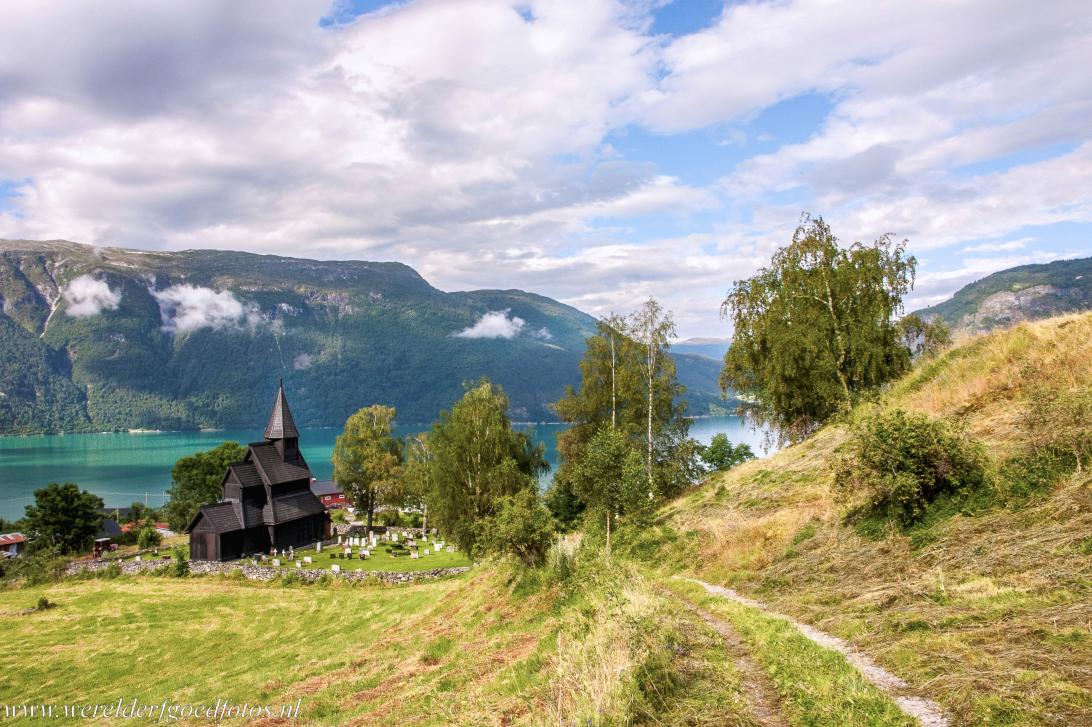Urnes Stave Church: A stave church has been built three times on the same location at Urnes, a hundred years would pass between the first and the third, the present Urnes Stave Church. The Urnes Stave Church is situated in Luster in the magnificent natural setting along the Lustrafjord, a branch of the Sognefjord. The stave churches are named after the load bearing wooden posts, called staves, in the wall construction. The staves are placed in the corners and are important connecting points for the vertical wall planks. Similar wooden churches were built elsewhere in Europe, but only the Norwegian stave churches have survived. In the Middle Ages, there were probably more than 1000 stave churches in Norway, now only 28 remain. Most of the surviving stave churches in Norway were built between 1150 and 1350. The Undredal Stave Church is the smallest stave church in Norway, the Urnes Stave Church is the oldest and most decorated stave church. The Urnes Stave Church gained the status as a UNESCO World Heritage in 1979.
www.werelderfgoedfotos.nl © Copyright World Heritage Photos

The Urnes Stave Church, in the background the Lustrafjord. The wooden church is surrounded by the breathtaking nature of Norway The Urnes Stave Church was once the private church of a wealthy and powerful high-born family. In the medieval period, Norway had a strong tradition for using wood in constructions and art work. The Urnes Stave Church is an unique example of this technique. The Urnes Stave Church was declared a UNESCO World Heritage in 1979.

The Urnes Stave Church, in the background the Lustrafjord. The wooden church is surrounded by the breathtaking nature of Norway The Urnes Stave Church was once the private church of a wealthy and powerful high-born family. In the medieval period, Norway had a strong tradition for using wood in constructions and art work. The Urnes Stave Church is an unique example of this technique. The Urnes Stave Church was declared a UNESCO World Heritage in 1979.

Urnes Stave Church: A stave church has been built three times on the same location in Urnes, a hundred years would pass between the first and third church, the present Urnes Stave Church. The timber was felled in the period 1129-1130. Similar churches were built elsewhere in Europe, but only the Norwegian stave churches have survived. There were probably over one thousand stave churches in Norway, nowadays, only twenty-eight remain.

Urnes Stave Church: The stave churches are named after their load bearing wooden posts, the staves, in the wall construction. The staves are the important connecting points for the vertical wall planks. There are several types of stave churches in Norway, but the common feature to all of the churches is that they have the 'staves' and a framework of timber with wall planks on sills. The stave churches are a valuable part of the architectural heritage of Norway.

Urnes Stave Church: A detail of the decorations on the northern outside wall of the church. The unique Urnes style has its name from the Urnes Stave Church: stylized animals in battle, the use of enclosures in the compositions, the contrasts between wide and narrow lines and the flowing outlines in the motives. The carved decorations often are a combination of Christian motifs and pre-Christian Viking art with animals and dragons.

Urnes Stave Church: The original decorated parts of an earlier church on the same site consists of the wall planks and an elaborately carved gateway. The Urnes Stave Church is the oldest and most decorated of the twenty-eight remaining stave churches in Norway. Most of the remaining stave churches were built between the 12th century and 14th centuries. The Urnes Stave Church gained the status as a UNESCO World Heritage in 1979.

Urnes Stave Church: The original decorated sections from an earlier church have been used on the northern wall, probably parts of the portal, wall planks and a corner post. In the field on the lower left there is a lion with characteristic mane. Over and around the lion there is a network of snakes and ring shaped animals. It is possible that the decorations of the earlier stave church depict scenes from Norse mythology, or the eternal fight between good and evil.

Urnes Stave Church: The interior of the church is exceptionally and richly decorated with motifs such as doves, centaurs and dragons, this decoration has become known as the Urnes style. The stave churches are major examples of the wooden medieval architecture in Europe and are also a valuable part of the architectural heritage of Norway. The use of cameras is not allowed inside the Urnes Stave Church.

The Urnes Stave Church is located in the small village of Ornes in the municipality of Luster. The church stands in the magnificent natural setting along the wonderful green tinted waters of the Lustrafjord, a side arm of the Sognefjord, the longest and deepest fjord in Norway. The church is the oldest Stave Church in Norway. The Urnes stave church was inscribed on the UNESCO World Heritage List in 1979.
